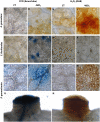Ozone Impact on Emission of Biogenic Volatile Organic Compounds in Three Tropical Tree Species From the Atlantic Forest Remnants in Southeast Brazil
- PMID: 35812949
- PMCID: PMC9263830
- DOI: 10.3389/fpls.2022.879039
Ozone Impact on Emission of Biogenic Volatile Organic Compounds in Three Tropical Tree Species From the Atlantic Forest Remnants in Southeast Brazil
Abstract
Plants emit a broad number of Biogenic Volatile Organic Compounds (BVOCs) that can impact urban ozone (O3) production. Conversely, the O3 is a phytotoxic pollutant that causes unknown alterations in BVOC emissions from native plants. In this sense, here, we characterized the constitutive and O3-induced BVOCs for two (2dO3) and four (4dO3) days of exposure (O3 dose 80 ppb) and evaluated the O3 response by histochemical techniques to detect programmed cell death (PCD) and hydrogen peroxide (H2O2) in three Brazilian native species. Croton floribundus Spreng, Astronium graveolens Jacq, and Piptadenia gonoacantha (Mart.) JF Macbr, from different groups of ecological succession (acquisitive and conservative), different carbon-saving defense strategies, and specific BVOC emissions. The three species emitted a very diverse BVOC composition: monoterpenes (MON), sesquiterpenes (SEQ), green leaf volatiles (GLV), and other compounds (OTC). C. floribundus is more acquisitive than A. graveolens. Their most representative BVOCs were methyl salicylate-MeSA (OTC), (Z) 3-hexenal, and (E)-2-hexenal (GLV), γ-elemene and (-)-β-bourbonene (SEQ) β-phellandrene and D-limonene (MON), while in A. graveolens were nonanal and decanal (OTC), and α-pinene (MON). Piptadenia gonoachanta is more conservative, and the BVOC blend was limited to MeSA (OTC), (E)-2-hexenal (GLV), and β-Phellandrene (MON). The O3 affected BVOCs and histochemical traits of the three species in different ways. Croton floribundus was the most O3 tolerant species and considered as an SEQ emitter. It efficiently reacted to O3 stress after 2dO3, verified by a high alteration of BVOC emission, the emergence of the compounds such as α-Ionone and trans-ß-Ionone, and the absence of H2O2 detection. On the contrary, A. graveolens, a MON-emitter, was affected by 2dO3 and 4dO3, showing increasing emissions of α-pinene and β-myrcene, (MON), γ-muurolene and β-cadinene (SEQ) and H2O2 accumulation. Piptadenia gonoachanta was the most sensitive and did not respond to BVOCs emission, but PCD and H2O2 were highly evidenced. Our results indicate that the BVOC blend emission, combined with histochemical observations, is a powerful tool to confirm the species' tolerance to O3. Furthermore, our findings suggest that BVOC emission is a trade-off associated with different resource strategies of species indicated by the changes in the quality and quantity of BVOC emission for each species.
Keywords: VOC; ecological chemical trait; isoprenoid compounds; tropical plants; tropospheric ozone.
Copyright © 2022 Moura, Bolsoni, de Paula, Dias and Souza.
Conflict of interest statement
The authors declare that the research was conducted in the absence of any commercial or financial relationships that could be construed as a potential conflict of interest.
Figures




References
-
- Abis L., Kalalian C., Lunardelli B., Wang T., Zhang L., Chen J., et al. . (2021). Measurement report: biogenic volatile organic compound emission profiles of rapeseed leaf litter and its secondary organic aerosol formation potential. Atmos. Chem. Phys. 21, 12613–12629. doi: 10.5194/acp-21-12613-2021 - DOI
-
- Acton W. J. F., Jud W., Ghirardo A., Wohlfahrt G., Hewitt C. N., Taylor J. E., et al. . (2018). The effect of ozone fumigation on the biogenic volatile organic compounds (BVOCs) emitted from Brassica napus above- and below-ground. PLoS One 13, e0208825–e0208819. doi: 10.1371/journal.pone.0208825, PMID: - DOI - PMC - PubMed
-
- Alves E. S., Moura B. B., Pedroso A. N. V., Tresmondi F., Domingos M. (2011). The efficiency of tobacco Bel-W3 and native species for ozone biomonitoring in subtropical climate, as revealed by histo-cytochemical techniques. Environ. Pollut. 159, 3309–3315. doi: 10.1016/j.envpol.2011.08.043, PMID: - DOI - PubMed
-
- Anderson M. J. (2017). “Permutational multivariate analysis of variance (PERMANOVA)” in Wiley StatsRef: Statistics Reference Online, 1–15.
LinkOut - more resources
Full Text Sources

